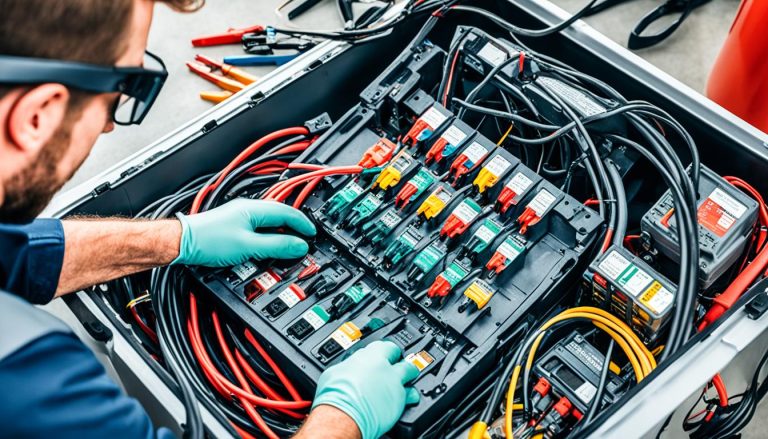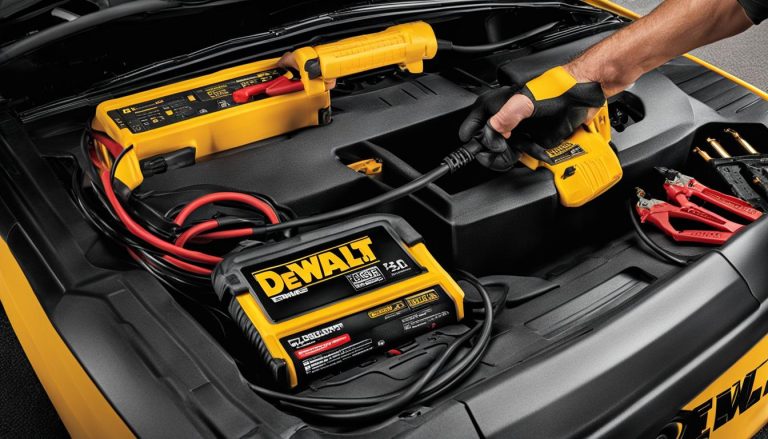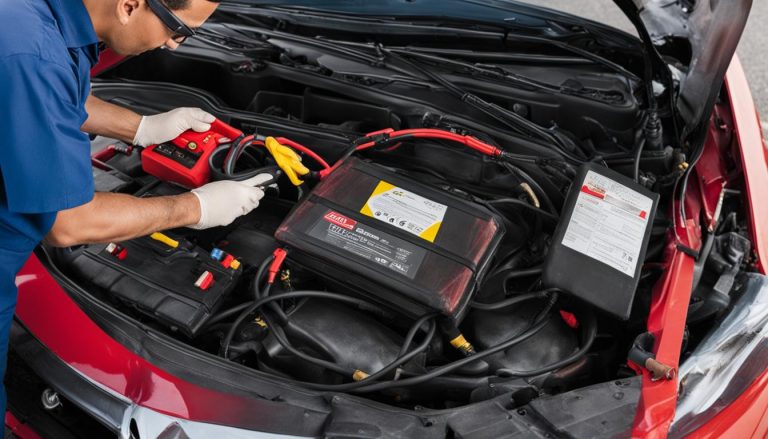Revive Your Car: How to Use Battery Jump Starter
batterychargers.site and its partners may earn a commission if you purchase a product through one of our links
Have you ever faced the sinking feeling of turning your car key, only to be greeted with silence? A dead battery is inconvenient at best, and an absolute hurdle when you least expect it. But fear not, with a battery jump starter at your side, you can take matters into your own hands. In this battery jump starter usage guide, we’ll walk you through how to use a battery jump starter, ensuring that you’re not left stranded. Mastering the intricacies of operating a portable car jump starter can be a lifesaver, and it’s simpler than you might think.
Key Takeaways
- Become self-reliant in jump-starting your car using a battery jump starter.
- Learn the correct operation to safely and effectively use a portable jump starter.
- Understand key safety measures to prevent damage to your car or jump starter.
- Discover the ease of this must-have tool in your vehicle’s emergency kit.
- Equip yourself with the knowledge to handle dead battery situations confidently.
- Appreciate the importance of having a charged jump starter ready for emergencies.
Grasping the Basics: Understanding Your Car’s Battery Needs
When it comes to maintaining your vehicle’s reliability, it’s fundamental to comprehend the significance of a robust car battery. Not only does a healthy battery ensure smooth startups, but it also fuels all the electrical components of your car. A thorough grasp of this automotive cornerstone is your starting point—the foundation for every informed driver’s journey.
The Role Your Car Battery Plays in Vehicle Functionality
Your battery sits at the heart of your vehicle’s electrical system, silently and reliably powering everything from your car’s ignition to the dashboard’s display. It’s the lifeline that feeds the starter motor and ignites the engine’s fuel and air mixture, allowing you to take to the road with confidence.
Signs That Indicate a Depleted Car Battery
Staying vigilant for the signs of a dead battery can avert the inconvenience and potential hazard of a car that won’t start. The telltale signs span from the obvious—a car that refuses to turn over—to the subtler hints like flickering lights or sluggish accessory performance. Let’s delve into these indicators in detail.
| Sign | Description | Immediate Action |
|---|---|---|
| Slow Engine Crank | When the engine turns over sluggishly or takes longer to start, your battery may be to blame. | Consider a battery test or charge before it fails completely. |
| Noisy Startup | A struggling or clicking sound while starting the engine can signal a weak battery connection. | Inspect battery terminals for corrosion or loose connections. |
| Electrical Issues | Dim headlights or the failure of electrical accessories points towards battery trouble. | Test the battery charge and review the alternator’s status. |
| Warning Light | The check battery or charging system light may illuminate on your dashboard. | Don’t ignore this alert; have your battery system checked soon. |
Armed with this knowledge and a beginner’s guide to using a battery jump starter, you’re well-equipped to detect a battery on the brink. Remember, the normal voltage for an idling car battery should hover around 12.6 volts. Falling below this benchmark suggests it’s time to recharge or, if persistent issues arise, replace the unit.
Your awareness and proactive approach can be the difference between a minor hiccup and a full-blown roadside ordeal. Keep these insights close, and you’ll be prepared to address battery issues head-on, ensuring your travels are as smooth and uninterrupted as the road ahead.
Choosing the Right Portable Battery Jump Starter for Your Vehicle
When you’re faced with a dead car battery, a portable battery jump starter can be a lifesaver. Selecting the appropriate jump starter for your vehicle not only ensures a quick start when needed but also contributes to the device’s longevity. Let’s delve into the factors you should consider to ensure you choose a compatible battery booster pack that meets your needs.
Compatibilities and Power Requirements
Before you invest in a jump starter, check its compatibility with your vehicle’s battery. Voltage is a crucial aspect to consider – most passenger vehicles require a 12-volt jump starter, while larger vehicles might need a 24-volt version. Pay attention to your vehicle manufacturer’s recommendations to avoid any mismatch in power requirements.
Evaluating Capacity and Current Output
Capacity and current output are key indicators of a jump starter’s performance. The battery’s capacity, indicated in milliamp-hours (mAh), determines how many charges it can deliver and, essentially, how many start attempts you have in case the first try doesn’t work. The current output, measured in amps, indicates the power provided to your dead battery at peak performance. Here’s a quick guide to help you assess the right capacity and current output for jump starters:
| Vehicle Type | Recommended Capacity (mAh) | Recommended Current (Amps) |
|---|---|---|
| Compact car | 6,000 – 10,000 | 300 – 400 |
| Sedan/SUV | 10,000 – 15,000 | 400 – 600 |
| Truck | 15,000 – 20,000 | 600 – 1000+ |
Considering Size, Weight, and Extra Features
Portability is an essential feature of a battery booster pack. You’ll want something compact enough to store conveniently in your vehicle, yet powerful enough to get the job done. Additionally, look for extra features that add value to your purchase, such as built-in flashlights for nighttime use or USB ports to charge your mobile devices. These extra features transform your jump starter into a versatile tool, especially during travel or emergencies.
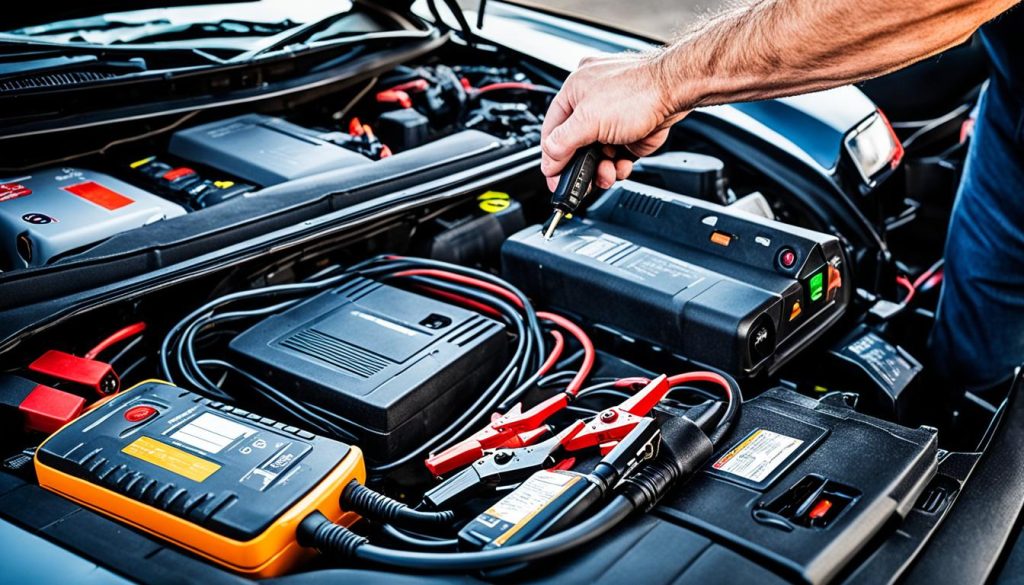
Armed with these insights and a better understanding of the jump starter realm, you’re now set to select a portable battery jump starter with confidence. Remember, when choosing a compatible battery booster pack, it’s not just about the immediate need—it’s also about ensuring you have reliable power assistance whenever you’re on the road.
Essential Safety Precautions When Handling a Jump Starter
Understanding and adhering to fundamental safety principles is critical when utilizing a jump starter. As you prepare to use this crucial emergency equipment, keeping a few important tips in mind will help you avoid hazardous situations and ensure the longevity of both your jump starter and vehicle battery.
Proper Connection Techniques to Prevent Short Circuits
When connecting a jump starter to your vehicle, the correct sequence is imperative. Jump starter safety precautions dictate that the positive and negative cables must be clamped to specific points to avoid the risk of a short circuit—a potentially dangerous situation.
- Connect the red, positive clamp to the battery’s positive terminal
- Attach the black, negative clamp to a solid, unpainted metal surface on the engine block rather than the negative terminal of the battery
This method will help maintain battery jump starter safety and safeguard the complex electronic systems of your vehicle.
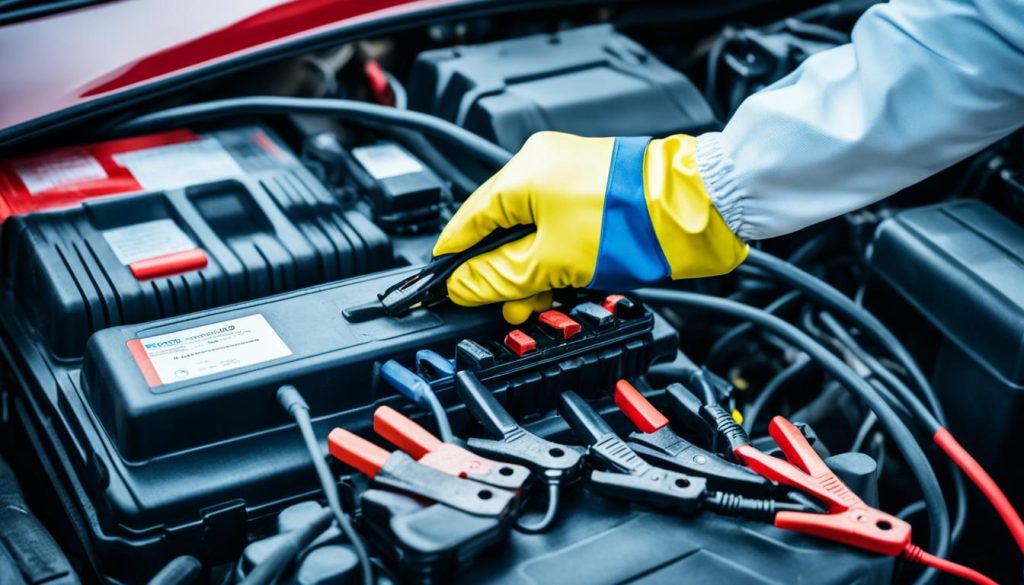
Avoiding Common Mistakes: What Not to Do
Many well-intentioned drivers make simple oversights that can lead to bigger issues down the line. To ensure the proper use of jump starters, it’s essential to steer clear of the following common errors:
- Do not rush to start the vehicle immediately; allow the jump starter to transfer some power to the battery first.
- Before attaching the jump starter, make certain that all vehicle accessories, lights, and electronics are off.
- Avoid connecting the cables incorrectly, as reversing the clamps can cause severe damage to both the jump starter and the vehicle.
By staying vigilant and proceeding with care, you’ll be more likely to enjoy a safe and successful jump-starting experience with your vehicle.
How to Use Battery Jump Starter: A Step-by-Step Guide
Preparation is key when it comes to efficiently jump-starting your vehicle. In this guide, we’ll walk through the essential steps to jump-start a car with a battery jump starter, making sure you’re equipped to handle this situation safely and effectively.
Firstly, ensure your car’s engine is off and all electronic devices are disabled. This minimizes the risk of electrical surges. Now, you’re ready to connect your portable car jump starter:
- Locate your car’s battery and identify the positive and negative terminals. The positive is usually marked with a red cap or a plus sign (+).
- Take the positive (red) clamp of the jump starter and attach it securely to the positive terminal of the battery.
- Find a non-painted metal surface on your car’s engine block and connect the negative (black) clamp to this grounding point.
With the clamps properly attached, it’s time to start your car:
- Switch on the jump starter. Some models may have a button or switch, so follow the manufacturer’s instructions.
- Wait a few moments to allow the jump starter to supply power to your car’s battery.
- Try starting your vehicle. If it doesn’t start right away, do not worry. Simply allow the jump starter to continue charging the battery for a few more minutes and try again.
Once your engine is running smoothly, carefully disconnect the clamps in the reverse order:
- Turn off the jump starter.
- Remove the negative (black) clamp from the grounding point on the engine block.
- Finally, remove the positive (red) clamp from the battery’s positive terminal.
Remember to recharge your portable car jump starter after use to ensure it’s ready for the next emergency. Adhering to these steps when operating your jump starter will help you get back on the road quickly and safely.
Jump Starting a Dead Battery with a Jump Starter: The Detailed Process
When faced with a dead car battery, the key to getting back on the road quickly is knowing how to use a battery jump starter. This comprehensive guide walks you through the steps required for jump-starting a dead battery with a jump starter, so you’re prepared whenever your vehicle needs a boost.
Connecting the Jump Starter to Your Car Battery
Before you begin the process, ensure the jump starter is fully charged and that your vehicle and its electrical components are turned off. Follow these essential steps:
- Locate your car’s battery and identify the positive and negative terminals. The positive terminal is usually marked with a plus (+) sign or a red cover.
- Attach the positive (red) clamp of the jump starter to the positive post of your battery.
- Find a non-painted metal surface on the engine block to serve as a grounding point and attach the negative (black) clamp there.
- Make certain that the cables are securely connected and free from any moving parts.

The Initial Startup and Subsequent Actions
After setting up the connection, activate the jump starter, usually by switching it on or pressing the designated power button. Then, proceed as follows:
- Attempt to start your vehicle by turning the key or pressing the start button. Do not crank the engine for more than a few seconds as this could damage the jump starter.
- If the engine does not start right away, turn off the ignition, and allow the jump starter to send more charge to the battery for a few more minutes.
- Try starting the engine again. If it’s still unsuccessful, check the connections and the charge level of the jump starter before another attempt.
- Once the engine is running, let it idle to help the alternator charge the battery.
- Finally, disconnect the jump starter, starting with the negative clamp, followed by the positive clamp, ensuring your face and body are clear of the battery as you remove the cables.
Follow this table for a quick reference on the do’s and don’ts when using your jump starter:
| Do’s | Don’ts |
|---|---|
| Ensure the jump starter is fully charged before use. | Don’t connect the negative clamp to the negative terminal of the battery. |
| Turn off the vehicle and all electronics before connecting. | Don’t attempt to jump-start a frozen battery. |
| Read and follow the jump starter’s instruction manual. | Don’t leave the jump starter connected for too long after the vehicle starts. |
| Disconnect the jump starter immediately after the vehicle starts. | Don’t use a jump starter on a battery that’s damaged or leaking. |
By familiarizing yourself with this process of jump-starting a dead battery with a jump starter, you’re empowering yourself to tackle unexpected battery issues with confidence. Remember to handle your jump starter with care and strictly adhere to these guidelines for a safe and successful jump-start.
Tips for Maintaining Your Jump Starter and Car Battery
Attentive care for your jump starter and car battery is not just about extending their lifespans—it’s also about ensuring your safety and keeping you on the road. By adopting best practices for using battery jump starters and maintaining your car battery, you can minimize the chances of facing vehicular troubles when you least expect them.
Regular Charging and Storage Tips for Your Jump Starter
To keep your jump starter in peak condition, regular charging is a must. Even if you haven’t used it, aim to charge it every three to six months to keep the battery healthy. When it comes to storage, a temperate environment is key. Extreme cold or heat can degrade the jump starter’s battery over time. Of course, accessibility is important; store your jump starter in a location within your car that’s easy to reach in case of an emergency.
Routine Checks and Maintenance for Car Battery Longevity
Maintaining your car battery involves a few straightforward but crucial steps. First, ensure that the battery terminals are free of corrosion and are tightly secured. A bit of baking soda and water can clean off any corrosion, keeping the connection strong. Secondly, keeping an eye on your car battery’s charge level can help you avoid unexpected power loss. Finally, during routine vehicle maintenance, request that your mechanic checks the battery’s state of health. This small effort can lead to significant savings by avoiding premature battery replacement.
- Inspect and clean battery terminals regularly to avoid power loss.
- Ensure jump starter and car battery are charged and in good working order.
- Store your jump starter in a cool, dry place inside your vehicle for emergencies.
Remember, being proactive about maintaining your car battery and jump starter can save you a considerable amount of time and money, and keep you out of harm’s way on busy roads.
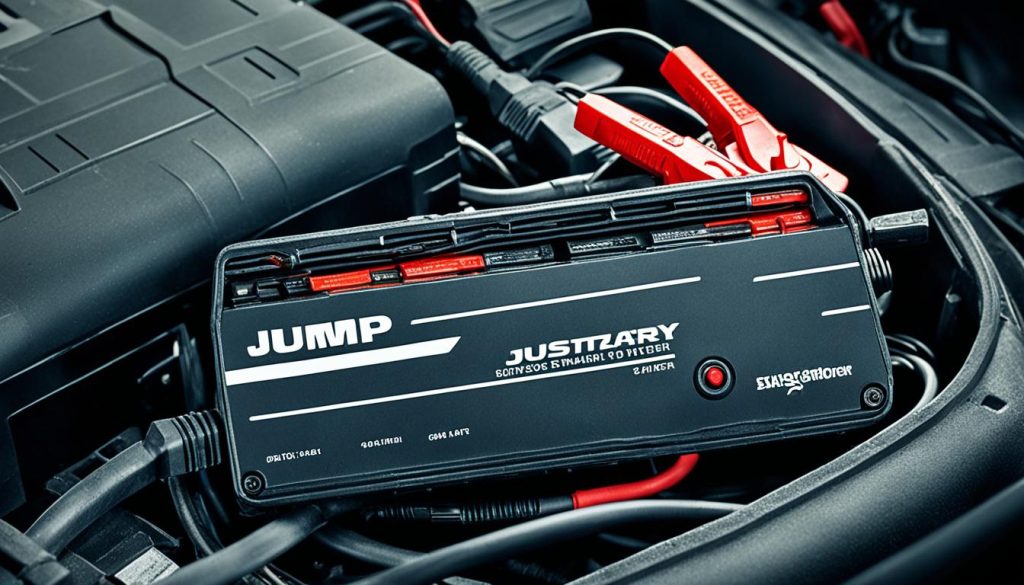
Maximizing the Lifespan of Your Jump Starter and Car Battery
To safeguard your investment and ensure the dependability of your emergency equipment, it’s important to adhere to certain care and maintenance practices. By following established recharging protocols and understanding the nuances of seasonal battery care, you can enhance the longevity and performance of both your battery jump starter and car battery. Let’s delve into some key strategies that will help you achieve this.
Recharging Protocols for Optimum Performance
First and foremost, engaging in appropriate recharging protocols is crucial for maximizing battery jump starter lifespan. Always recharge your jump starter promptly after each use. Avoiding prolonged periods of depletion not only extends the life of the device but also ensures that it’s always ready for action when you need it. It’s just as vital to keep your car battery charged, as a consistently low charge can lead to permanent battery damage and decreased capacity.
Seasonal Considerations and Long-term Storage Advice
Every season poses unique challenges for battery maintenance. In colder months, for example, your car battery suffers from increased strain and may require a trickle charger if the vehicle is not in regular use. As for your jump starter, proper long-term battery storage is important. This means storing it in a location that avoids extreme temperatures, keeping it fully charged, and checking on its state periodically. By respecting these practices, you can ensure that both your car battery and jump starter remain reliable and effective year-round.
Maximizing the Lifespan of Your Jump Starter and Car Battery
What role does my car battery play in vehicle functionality?
Your car battery is vital for kickstarting the engine and powering all the electrical systems within your vehicle. Without a charged and functional battery, your car won’t be able to start.
How can I tell if my car battery is depleted?
A dead or depleted battery will often be indicated by an engine that fails to start, headlights that are dim or flickering, and electrical accessories that no longer operate. It’s important to recognize these signs to avoid getting stranded.
What should I look for when choosing a battery jump starter for my car?
Ensure the jump starter is compatible with your vehicle’s battery voltage and has sufficient current output. Also, consider the size and weight for portability, as well as additional features like USB ports or emergency lights.
What do capacity and current output mean for jump starters?
Capacity, measured in milliamp-hours (mAh), indicates how much electrical charge a jump starter can hold. Current output, measured in amps, shows how much power the jump starter can deliver to your car’s battery.
Why should I consider a jump starter’s size, weight, and extra features?
These factors affect the portability and usability of the jump starter. Additional features, such as built-in flashlights or USB charging ports, can provide extra utility in various situations.
What are the correct connection techniques to prevent short circuits?
To prevent short circuits, connect the positive clamp to the positive battery terminal and the negative clamp to a grounding point on the engine block. This ensures a safe jump-starting process.
What are common mistakes to avoid when using a jump starter?
Avoid connecting the clamps incorrectly, attempting to start the car immediately without letting the jump starter do its work, and make sure all accessories and lights are off before using the jump starter.
How do I connect a jump starter to my car battery correctly?
Attach the positive cable to the battery’s positive post and the negative cable to a metal part of the engine block. Turn on the jump starter, and after a short wait, try starting your car.
What should I do if my car doesn’t start right away?
If your car doesn’t start immediately, wait a couple of minutes to allow the jump starter to charge the battery a bit more. Then, attempt to start the engine again.
How should I charge and store my jump starter?
Regularly charge your jump starter and store it in a cool, dry place. Ideally, keep it within easy reach in your vehicle for emergency situations.
What routine maintenance should I perform on my car battery?
Keep the battery terminals clean, check the charge level regularly, and follow the manufacturer’s guidelines for proper maintenance to ensure battery longevity.
What recharging protocols should I follow for my jump starter?
Recharge your jump starter after each use, and avoid leaving it depleted for long periods. This helps maintain the jump starter’s battery health and readiness.
Are there any seasonal considerations or long-term storage advice for my jump starter?
Yes, cold weather can strain batteries, so take measures like using a trickle charger for vehicles not in regular use. For long-term storage of the jump starter, keep it fully charged and in a temperature-controlled environment.



